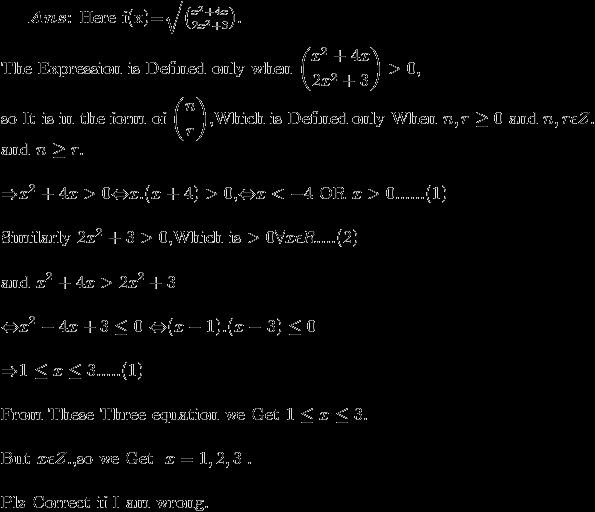4) For this one, we'll have a bunch of tricky restrictions. x² + 4x and 2x² + 3 will have to be positive integers. I won't be going into non-integer factorials, because those require gamma functions/integrals...not sure whether those are in JEE syllabus.
R1 : Square root function.
x² + 4xC2x² + 3 ≥ 0
=> Always true. x belongs to the integer set Z+.
R2 : Positivity of numbers being operated on by C.
x(x + 4) > 0
=> x < -4 U x > 0
AND
2x² + 3 > 0
=> x can be any value.
Taking intersection, finally R2 is x < -4 U x > 0.
R1 ∩ R2 gives the domain as integers less than -4 and greater than 0. If there is a better way to solve this, I'd love to know..
5) For the GINT function, here's an exhaustive collection of properties -: http://www.targetiit.com/iit-jee-forum/posts/greatest-integer-function-exhaustive-collection-pl-13636.html. Check out the last(mine) post too.
f(x) = sin-1[2x² - 3]
R1 : Arcsin input always lies between -pi/2 to pi/2.
-pi/2 ≤ [2x² - 3] ≤ pi/2
We check these out separately.
[2x² - 3] ≥ -pi/2
The equal to part is not possible as the LHS is an integer and the RHS is not.
So [2x² - 3] > -pi/2 or > -1.57
This can be written as [2x² - 3] ≥ -1 so that both sides are integral.
For the output of the GINT function to be an integer greater than or equal to -1, 2x² - 3 ≥ 0 OR 2x² - 3 = -1.
So x ≤ -√3/2 U x ≥ √3/2 U {1, -1}
Similarly do [2x² - 3] ≥ pi/2 and take the intersection of both cases to get the domain...phew.

